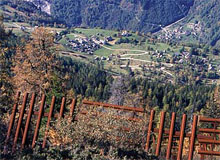
Most of the destruction was the result of 1,200 avalanches, which blocked up to 100 roads and railway tracks, damaged1,700 buildings, destroyed 3,500 acres of protected forest, and killed 17 people. But, all things considered, Switzerland got off lightly—and it has its forests to thank.
Aside from their sheer beauty, the numerous Swiss forests shield people from avalanches, falling rock, and other natural hazards. As a result, the management of these “protection forests”—forests that provide protection from natural hazards—has top priority within the Swiss forest policy at federal and local levels.
For many tourists, Wengen, located in the Bernese Oberland, is a car-free, idyllic resort in the heart of the Alps. Only the perpetual ice of the majestic peaks of the Eiger, Mönch, and Jungfrau indicate the hostile environment. Every January, underneath the Lauberhorn, the best skiers race at speeds of up to 100 miles per hour, down the longest ski run in the world. It is a place where natural hazards such as rock and snow avalanches and mud slides threaten people and the surrounding communities year-round.
Since trees offer practically the only protection from falling boulders and snow masses, the private and public forest owners manage the forests to protect the village rather than to produce commercial timber. For the forest to guarantee permanent protection, natural regeneration needs to be supported with regular cuts, and a heterogenous stand structure needs to be maintained. The short vegetation period, however, leads to a very slow rate of tree growth and decades can pass before a new forest becomes effective. In the interim, windstorms or bark beetles may have devastating effects.
Falling Production
Until 50 years ago, protection forests were managed for commercial timber. Initially, local regulations prohibited the overuse of the forest as well as clear cutting. Later, national policy was implemented to prevent misuse of the forests. Nevertheless, comparable high prices for wood led to regular harvests even on the steepest slopes of the Alps—leaving protection in the wake of the forest industry.
Over the past several decades, the tide has turned. International timber markets and other factors like cheap oil and a growing living standard put massive pressure on alpine wood production and have led to an abandonment of wise forest management. Unfortunately, this generally advantageous aspect of economic development has also led to an increasingly unstable regeneration for many important protection forests. It would be financially impossible to replace all protection forests with man-made constructions to protect against avalanches and falling rock. Thus, public authorities are confronted with the question of how to best provide proper management of the protection forests.
Growing Constraints
Protection forests are often private property. Although ownership structures are complicated, it is estimated that 67 percent of protection forests are privately owned and 33 percent are public. A forest policy based on Swiss classical liberalism naturally seeks to move away from any possible constraints. In contrast, the public aims to motivate forest owners with cash incentives and financial appeals in return for the proper management of protection forests, thus avoiding the state’s right to exercise eminent domain. Practical experience shows that this policy of paying annually more than US $100 per acre of protection forest works quite well and eminent domain is considered the exception rather than the rule. With extended forest damage due to hurricanes and bark beetles, there is the tendency to impose more duties on forest owners to “clean up” their forests, diluting her or his property rights.
In recent years, there has been a political movement pushing for risk-based assessment and cost-benefit analyses to determine funding for protection forest projects in Switzerland. Without these criteria for allocating funds, some politicians and the forest service often pursue a slightly different agenda—avoiding politically unpopular decisions or directing too much funding into their region. As a result, politically well-organized small villages receive public funding for forest management, leaving larger one slacking. A new risk assessment-based approach would improve the system.
Micromanagement
Once the funding for the management of protection forests is secured, questions arise such as which silvicultural measures should be considered and with what kind of intensity? This question opens several issues: First, forest owners and their foresters have more information available to them than the funding authorities do, so owners tend to exaggerate the importance of costly measures. Second, the usefulness of the silvicultural measures is difficult to assess for everybody since as many as two to three decades may pass between when the first management measure is implemented and its outcome. Third, the assessment of the gained protection effect is linked to significant methodological difficulties such as determining what kind of stand structure is really needed to protect people and infrastructure. In addition, the entire forest industry has trouble applying economic thinking, such as weighing marginal costs against benefits. Due to these issues, protection forest projects are often oversized and lack a clear purpose.
Fortunately, during recent years, finance politicians have delegated most of the funding distribution to the lower administrative levels within the cantons (states).With this, unjustified projects are not yet a thing of the past, but the cantons now have an easier starting position as well as the chance to learn from past mistakes of the federal administration micromanaging protection forest projects.
It is not easy for the cantons to promote the appropriate incentives. Subsidizing timber harvesting, for example, is an unsuitable measure because it does not efficiently allocate resources; the distribution of public resources should lead to a maximum reduction of risk and not to an increased utilization of wood. The public funding allocated to protection forests has led to unintended consequences. For example, outdated management techniques have survived and thus reduced the competitiveness of forest enterprises.
An interesting approach is the cantons paying lumps sums to forest owners for a time period of ten years, with the amount of money dependent upon the achieved stand structure. But this approach inevitably leads to an ethical question for some forest owners: Why incur the costs to maintain a protection forest’s vitality today if tomorrow government will restore the protection forest for free? Based on long-term considerations, this would mean that government should reimburse owners who effectively manage protection forests today. The owners could then take advantage of an incentive to further maintain the structure and regeneration of the protection forest and to invest in the respective measures.
Tricky Business
Due to great economic wealth in Switzerland, it will certainly be possible to allocate sufficient resources for the prevention of natural hazards. But which measures may be used most efficiently to maintain protection forests in the long term is a subject of speculation. Each approach must be thoroughly tested prior to the assessment of its advantages and disadvantages. It remains to be seen if each canton can pursue its own strategy and if over the years experimentation via competition among bureaucratic systems may help uncover the appropriate social arrangement.



